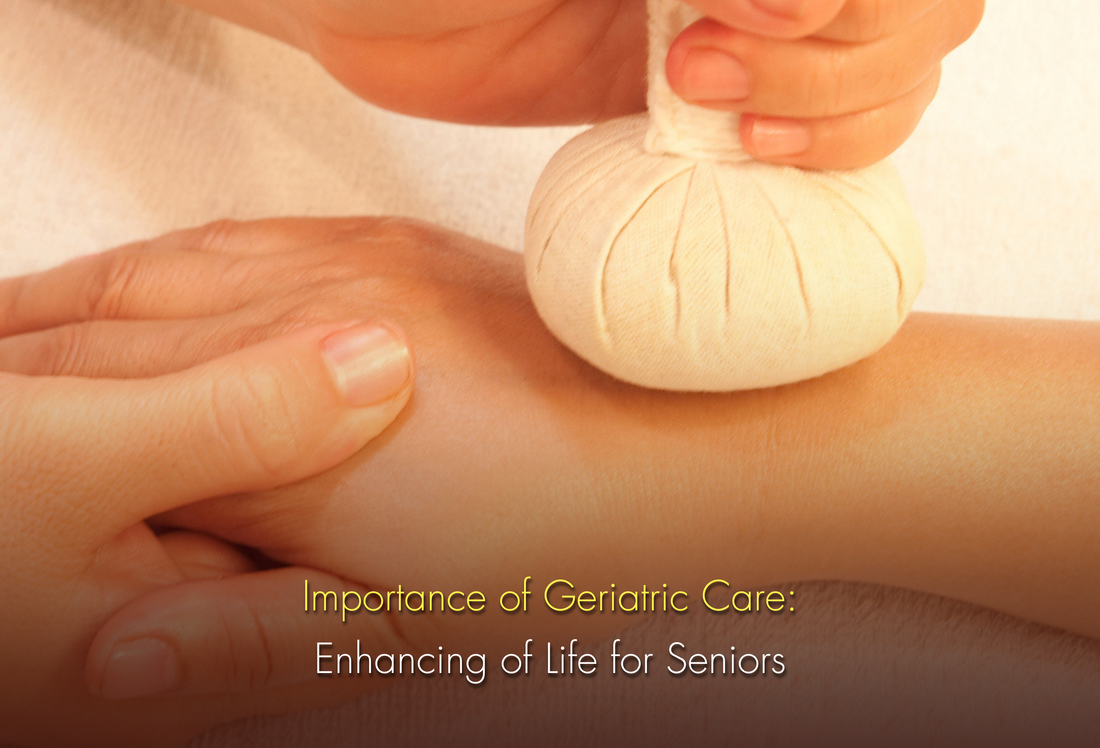
Importance of Geriatric Care: Enhancing of Life for Seniors
The process of physical, psychological, and social change in multi-dimensional aspects is called aging. Advancement of age comes with numerous problems too. Geriatric problems may be categorized into four categories, such as physical, psychological, emotional, and social.
Physical problems can include cardiovascular diseases, hypertension, myocardial infarction, asthma, bronchitis, osteoporosis, osteoarthritis, gouty arthritis, stiffness, dyspepsia, flatulence, constipation, prostate enlargement, nocturia, diabetes, cataracts, glaucoma, loss of hearing, insomnia, menopausal disorders, and even cancer.
Psychological problems can include dementia, depression, anxiety, etc. Aging can be associated with mental abuse, adjustment problems, insecurity, financial problems, etc. For all these reasons, geriatric care is the most necessary thing for elderly people.
Ayurveda and Geriatric Care:
In Ayurveda, the care of the elderly, or geriatric care, holds great importance in enhancing the quality of life for seniors. Rasayana Chikitsa is a special branch of Ayurveda that helps in geriatric care. Geriatric care plays a crucial role in enhancing the quality of life for seniors, ensuring they maintain dignity, independence, and well-being as they age.
Vata Dosha and Aging in Ayurveda:
As we age, the Vata dosha increases, leading to all Vata vyadhis in the body. An increase in age results in depletion of the agni as well. This results in the depletion of the dhatus, ojus, virya, indriya, and bala. Aging according to Ayurveda is Swabhavika Vyadi, which means to say that it is meant to happen and is inherent by nature. Ayurveda helps in maintaining the balance in the doshas and helps in graceful aging.
Digestive Issues and Ayurveda:
The first thing an elderly complains of is loss of appetite, bloating, and constipation. Ayurveda medication consisting of jeera, ginger, chitraka, hing, amla, haritaki, vibhitaki, etc. helps in the restoration of Agni and helps in vata automata, which helps in the correction of the agni. This improves the digestive fire and reduces bloating and constipation. Ayurveda also advises having timely meals that are rich in fiber. Regular intake of vegetables and fruits along with green leafy vegetables helps keep gut health in check.
Musculoskeletal Disorders in Aging:
Musculoskeletal disorders: Old age is associated with aches and pains. An increase in Vata leads to weakness in the joints and muscles. This leads to arthritis, swelling, and stiffness in joints. There are many vata hara medications in Ayurveda, such as Dashamula, Brihat Panchamula, Laghu Panchamula, Guggulu, Shallaki, etc., that can reduce vata dosha and decrease pain. Treatments such as abhyanga (oil massage), janu basti, greeva basti, kati basti, basti (enema), patra pinda bashpa sweda, and churna sweda all help in reducing inflammation and providing strength to the body.
Dementia and Ayurveda:
Dementia is another problem of old age. Nasya treatment and herbs such as Brahmi, Ashwagandha, Shankhapushpi, Jatamansi, etc. help in the restoration of memory and strength. Treatments such as Shirodhara, Shiro abhyanga, and nasya treatment have proven to be helpful in dementia.
Insomnia in the Elderly:
Insomnia is yet another major issue in old age. As a person ages, his sleep is deprived. Chronic insomnia can lead to fatigue, stress, and anxiety issues. Nidra nasha is one of the vata nanatmaja vikaras described in Ayurveda. Lifestyle changes, warm comforting food, yoga, meditation, and yoga nidra help in inducing better sleep in old age.
Ayurveda targets balancing the imbalanced dosha along with the restoration of vitality and strength. Ayurveda helps in graceful aging. Lifestyle correction, a balanced diet, and yoga together help in combating problems related to geriatric.
Chair Surya Namaskara for the Elderly:
Here is Chair Surya Namaskara that can be practiced by the elderly, which will help in the restoration of energy, combat pain, and give better sleep.
Chair Suryanamaskar:
The Classical Surya Namaskar is modified and made less challenging for those who are unable to balance the body in a standing position. Using a strong wooden or iron chair is recommended for this practice. Kindly avoid the use of plastic chairs for the practice.
Step 1: Hands Chest Chair - Pranamasana
- Sit on the chair with feet close to each other while the hands are in Namaskara Mudra placed in front of your chest.
- Sit straight without resting the torso on the back of the chair, and extend the spine and torso upwards, making sure the sitting bones are placed on the chair comfortably.
- Keep your eyes closed and breathe slowly and deeply while you observe the movement of your abdomen.
- Make sure that the thighs are parallel to the floor while the feet are firmly placed on the ground (if required, use blocks and place your feet on the blocks)
- Stay there for 5 – 10 breaths
Step 2: Hands up Chair – Hasta Uttanasana
- Inhale and raise the hands above the head from namaskara mudra.
- Extend the arms beyond the head and try extending it such that the biceps touch the ears
- If it’s not possible then try to stretch to your comfort level.
- Stay in this position with normal breathing observe the parts that are working and be aware of your breathing.
- Remember to stretch from the hips upwards, right up to the tips of the fingers.
Step 3: Seated Forward Bend Pose on Chair – Padahastasana
- From Hans above head exhale and bend forward at the torso.
- With exhalation, slowly take the arms down and place the palms close to your feet.
- The entire torso should rest on the thighs, bringing the chin to be placed as close to the knee as possible and looking down at your feet.
- Breathe normally and observe the movements of the torso; if needed, a cushion can be placed on the thighs to make breathing more comfortable.
Step 4: Seated low lunge Chair Variation (Anjaneyasana Variation in the chair)
- Inhale and come up to sit back straight on the chair.
- Further, inhale and raise the right leg up and hold the right thighs with your hands while bending the knee.
- Exhale and press the thighs towards the chest while you press the right knee and the right hips in the seated pose.
- Balance the right leg, holding it well in your hands, and look straight while your left foot is firmly placed on the floor or block.
- Lean back for support, feeling the stretch at the hips, lower back, hamstrings, knee, and ankle.
Step 5: Knee Head down Chair
- Releasing from the low lunge pose, inhale, and while exhaling, press the thighs closer to you while you bring the face towards the knee, flexing your neck.
- Press the thighs, rest the nose on the knee in the knee head down chair pose, and breathe normally.
- Rest your back completely and make sure you get a grip of the hips and the foot on the floor to avoid slipping from the chair.
Step 6: Hands up Chair – Hasta Uttanasana
- Inhale, release, and go back to the hands-up chair pose, placing the feet firmly on the floor or block and stretching the arms above the head and shoulder.
- Breathe normally and try to stretch deeper than Step 2
Step 7: Seated Forward Bend Pose on Chair – Padahastasana
- Exhale and go down, flexing the torso and the hips in the Padahastasana chair pose.
- Breathe normally and stay in the position for a few breaths.
Step 8: Seated Low Lunge Variation Chair (Anjaneyasana Variation Chair)
- Inhale and bend the left leg at the knee, pressing the thighs close to you while seated straight in a low lunge.
- Remain here for about 6 breaths and watch for the stretch at the left side of the hips, hamstrings, knee, and ankle.
- Breathe normally and be aware of breathing and the parts that you are working out.
Step 9: Hands-up Chair – Hasta Uttanasana
- Inhale, release, and go back to the hands-up chair pose, placing the feet firmly on the floor or block and stretching the arms above the head and shoulder.
- Breathe normally and try to stretch deeper than Step 2
Step 10: Hands Chest Chair – Pranamasana
- Exhale and bring your hands back to Namaskara Mudra while you sit straight on the chair.
- Keep your eyes closed breathe normally, and observe the parts that you worked out in the entire sequence.
Conclusion:
Age and aging are a natural part of human life that causes various physical, psychological, and emotional troubles. Ayurveda has a holistic plan of healthy aging, and it deals with the perfection of the three doshas, lifestyle, daily diet, and some forms of yoga such as the Chair Surya Namaskara. Applying such principles will help seniors to improve their quality of life as well as age gracefully, hence improving their health. For a personalized Ayurvedic care plan, book your appointment today at Sevayucuba and start your journey towards healthier aging.

